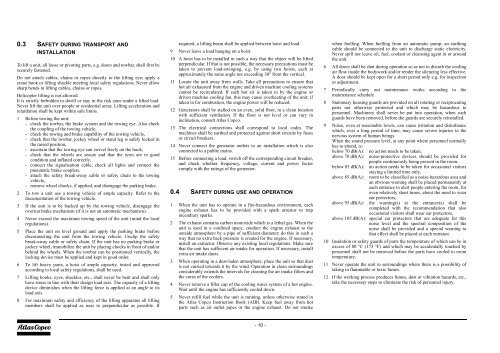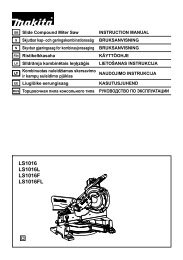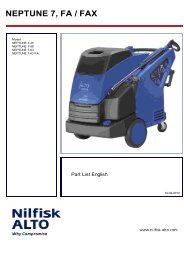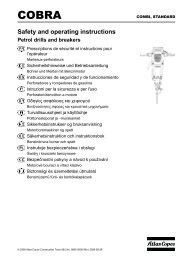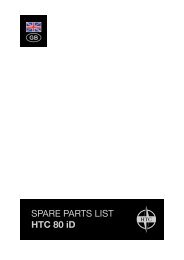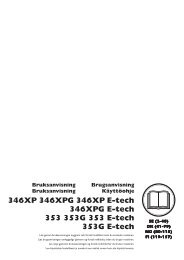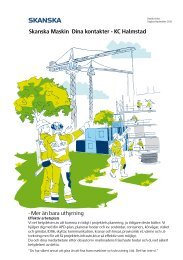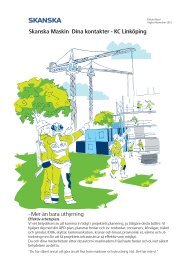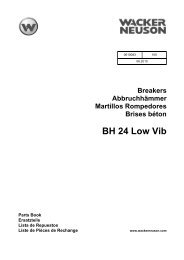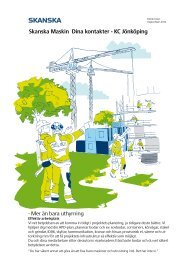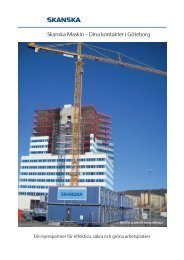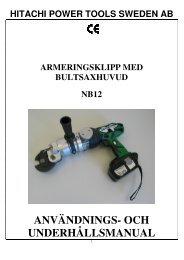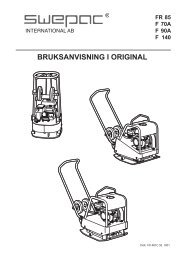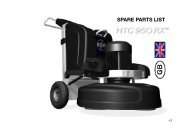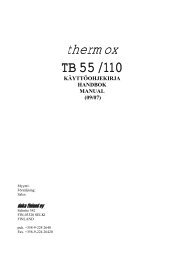QAX 40.book
QAX 40.book
QAX 40.book
Create successful ePaper yourself
Turn your PDF publications into a flip-book with our unique Google optimized e-Paper software.
0.3 SAFETY DURING TRANSPORT AND<br />
INSTALLATION<br />
To lift a unit, all loose or pivoting parts, e.g. doors and towbar, shall first be<br />
securely fastened.<br />
Do not attach cables, chains or ropes directly to the lifting eye; apply a<br />
crane hook or lifting shackle meeting local safety regulations. Never allow<br />
sharp bends in lifting cables, chains or ropes.<br />
Helicopter lifting is not allowed.<br />
It is strictly forbidden to dwell or stay in the risk zone under a lifted load.<br />
Never lift the unit over people or residential areas. Lifting acceleration and<br />
retardation shall be kept within safe limits.<br />
1 Before towing the unit:<br />
- check the towbar, the brake system and the towing eye. Also check<br />
the coupling of the towing vehicle,<br />
- check the towing and brake capability of the towing vehicle,<br />
- check that the towbar, jockey wheel or stand leg is safely locked in<br />
the raised position,<br />
- ascertain that the towing eye can swivel freely on the hook,<br />
- check that the wheels are secure and that the tyres are in good<br />
condition and inflated correctly,<br />
- connect the signalisation cable, check all lights and connect the<br />
pneumatic brake couplers,<br />
- attach the safety break-away cable or safety chain to the towing<br />
vehicle,<br />
- remove wheel chocks, if applied, and disengage the parking brake.<br />
2 To tow a unit use a towing vehicle of ample capacity. Refer to the<br />
documentation of the towing vehicle.<br />
3 If the unit is to be backed up by the towing vehicle, disengage the<br />
overrun brake mechanism (if it is not an automatic mechanism).<br />
4 Never exceed the maximum towing speed of the unit (mind the local<br />
regulations).<br />
5 Place the unit on level ground and apply the parking brake before<br />
disconnecting the unit from the towing vehicle. Unclip the safety<br />
break-away cable or safety chain. If the unit has no parking brake or<br />
jockey wheel, immobilize the unit by placing chocks in front of and/or<br />
behind the wheels. When the towbar can be positioned vertically, the<br />
locking device must be applied and kept in good order.<br />
6 To lift heavy parts, a hoist of ample capacity, tested and approved<br />
according to local safety regulations, shall be used.<br />
7 Lifting hooks, eyes, shackles, etc., shall never be bent and shall only<br />
have stress in line with their design load axis. The capacity of a lifting<br />
device diminishes when the lifting force is applied at an angle to its<br />
load axis.<br />
8 For maximum safety and efficiency of the lifting apparatus all lifting<br />
members shall be applied as near to perpendicular as possible. If<br />
required, a lifting beam shall be applied between hoist and load.<br />
9 Never leave a load hanging on a hoist.<br />
10 A hoist has to be installed in such a way that the object will be lifted<br />
perpendicular. If that is not possible, the necessary precautions must be<br />
taken to prevent load-swinging, e.g. by using two hoists, each at<br />
approximately the same angle not exceeding 30° from the vertical.<br />
11 Locate the unit away from walls. Take all precautions to ensure that<br />
hot air exhausted from the engine and driven machine cooling systems<br />
cannot be recirculated. If such hot air is taken in by the engine or<br />
driven machine cooling fan, this may cause overheating of the unit; if<br />
taken in for combustion, the engine power will be reduced.<br />
12 Generators shall be stalled on an even, solid floor, in a clean location<br />
with sufficient ventilation. If the floor is not level or can vary in<br />
inclination, consult Atlas Copco.<br />
13 The electrical connections shall correspond to local codes. The<br />
machines shall be earthed and protected against short circuits by fuses<br />
or circuit breakers.<br />
14 Never connect the generator outlets to an installation which is also<br />
connected to a public mains.<br />
15 Before connecting a load, switch off the corresponding circuit breaker,<br />
and check whether frequency, voltage, current and power factor<br />
comply with the ratings of the generator.<br />
0.4 SAFETY DURING USE AND OPERATION<br />
1 When the unit has to operate in a fire-hazardous environment, each<br />
engine exhaust has to be provided with a spark arrestor to trap<br />
incendiary sparks.<br />
2 The exhaust contains carbon monoxide which is a lethal gas. When the<br />
unit is used in a confined space, conduct the engine exhaust to the<br />
outside atmosphere by a pipe of sufficient diameter; do this in such a<br />
way that no extra back pressure is created for the engine. If necessary,<br />
install an extractor. Observe any existing local regulations. Make sure<br />
that the unit has sufficient air intake for operation. If necessary, install<br />
extra air intake ducts.<br />
3 When operating in a dust-laden atmosphere, place the unit so that dust<br />
is not carried towards it by the wind. Operation in clean surroundings<br />
considerably extends the intervals for cleaning the air intake filters and<br />
the cores of the coolers.<br />
4 Never remove a filler cap of the cooling water system of a hot engine.<br />
Wait until the engine has sufficiently cooled down.<br />
5 Never refill fuel while the unit is running, unless otherwise stated in<br />
the Atlas Copco Instruction Book (AIB). Keep fuel away from hot<br />
parts such as air outlet pipes or the engine exhaust. Do not smoke<br />
when fuelling. When fuelling from an automatic pump, an earthing<br />
cable should be connected to the unit to discharge static electricity.<br />
Never spill nor leave oil, fuel, coolant or cleansing agent in or around<br />
the unit.<br />
6 All doors shall be shut during operation so as not to disturb the cooling<br />
air flow inside the bodywork and/or render the silencing less effective.<br />
A door should be kept open for a short period only e.g. for inspection<br />
or adjustment.<br />
7 Periodically carry out maintenance works according to the<br />
maintenance schedule.<br />
8 Stationary housing guards are provided on all rotating or reciprocating<br />
parts not otherwise protected and which may be hazardous to<br />
personnel. Machinery shall never be put into operation, when such<br />
guards have been removed, before the guards are securely reinstalled.<br />
9 Noise, even at reasonable levels, can cause irritation and disturbance<br />
which, over a long period of time, may cause severe injuries to the<br />
nervous system of human beings.<br />
When the sound pressure level, at any point where personnel normally<br />
has to attend, is:<br />
below 70 dB(A): no action needs to be taken,<br />
above 70 dB(A): noise-protective devices should be provided for<br />
people continuously being present in the room,<br />
below 85 dB(A): no action needs to be taken for occasional visitors<br />
staying a limited time only,<br />
above 85 dB(A): room to be classified as a noise-hazardous area and<br />
an obvious warning shall be placed permanently at<br />
each entrance to alert people entering the room, for<br />
even relatively short times, about the need to wear<br />
ear protectors,<br />
above 95 dB(A):<br />
the warning(s) at the entrance(s) shall be<br />
completed with the recommendation that also<br />
occasional visitors shall wear ear protectors,<br />
above 105 dB(A): special ear protectors that are adequate for this<br />
noise level and the spectral composition of the<br />
noise shall be provided and a special warning to<br />
that effect shall be placed at each entrance.<br />
10 Insulation or safety guards of parts the temperature of which can be in<br />
excess of 80 °C (175 °F) and which may be accidentally touched by<br />
personnel shall not be removed before the parts have cooled to room<br />
temperature.<br />
11 Never operate the unit in surroundings where there is a possibility of<br />
taking in flammable or toxic fumes.<br />
12 If the working process produces fumes, dust or vibration hazards, etc.,<br />
take the necessary steps to eliminate the risk of personnel injury.<br />
- 10 -


